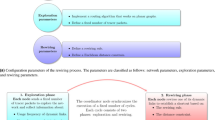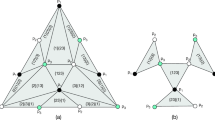Abstract
Although cellular automata (CA) are usually driven by a local rule, global communications are often needed either to synchronize a process or to share common data. However, these communications must be carried out from the nearest-neighbor, local transition. Such disseminations are named “systolic” herein: this metaphor is borrowed from the eponymous cellular architectures. The core of this study is the topology of the “arrowhead” family underlying the CA network in the hexagonal tessellation. The graphs of this family, directed or undirected, are Cayley graphs, or graphs of groups and are therefore vertex-transitive. As a consequence, the local rule is the same within the whole network. Two types of dissemination are presented: a (one–to–all) broadcasting and a (all–to–all) gossiping. For each type, a 3–port, directed scheme and a 6–port, undirected scheme are derived from construction. It is shown that the complexity of these algorithms is the graph diameter, either directed or undirected, according to the case study.
Access this chapter
Tax calculation will be finalised at checkout
Purchases are for personal use only
Preview
Unable to display preview. Download preview PDF.
Similar content being viewed by others
References
Moore, E.F.: The firing squad synchronization problem. In: Moore, E.F. (ed.) Sequential Machines, Selected Papers, pp. 213–214. Addison-Wesley, Reading (1964)
Umeo, H.: Firing squad synchronization problem in cellular automata. In: Encyclopedia of Complexity and Systems Science, pp. 3537–3574 (2009)
Désérable, D.: Propagative mode in a lattice-grain CA: time evolution and timestep synchronization. In: Sirakoulis, G.C., Bandini, S. (eds.) ACRI 2012. LNCS, vol. 7495, pp. 20–31. Springer, Heidelberg (2012)
Désérable, D., Dupont, P., Hellou, M., Kamali-Bernard, S.: Cellular automata in complex matter. Complex Systems 20(1), 67–91 (2011)
Chopard, B., Droz, M.: Cellular automata modeling of physical systems. Cambridge University Press, Cambridge (1998)
Fraigniaud, P., Lazard, E.: Methods and problems of communication in usual networks. Discrete Applied Mathematics 53(1-3), 79–133 (1994)
Kung, H.T.: Why systolic architectures? Computer 15(1), 37–46 (1982)
Liestman, A.L., Richards, D.: Perpetual gossiping. Par. Proc. Lett. 3(4), 347–355 (1993)
Hromkovič, J., Klasing, R., Unger, W., Wagener, H.: The complexity of systolic dissemination of information in interconnection networks. In: Cosnard, M., Ferreira, A., Peters, J. (eds.) CFCP 1994. LNCS, vol. 805, pp. 235–249. Springer, Heidelberg (1994)
Flammini, M., Pérennes, S.: Lower bounds on systolic gossip. Information and Computation 196(2), 71–94 (2005)
Chen, M.-S., Shin, K.G., Kandlur, D.D.: Addressing, routing and broadcasting in hexagonal mesh multiprocessors. IEEE Trans. Comp. 39(1), 10–18 (1990)
Morillo, P., Comellas, F., Fiol, M.A.: Metric problems in triple loop graphs and digraphs associated to an hexagonal tessellation of the plane, TR 05-0286 (1986)
Albader, B., Bose, B., Flahive, M.: Efficient communication algorithms in hexagonal mesh interconnection networks. J. LaTeX Class Files 6(1), 1–10 (2007)
Désérable, D.: Minimal routing in the triangular grid and in a family of related tori. In: Lengauer, C., Griebl, M., Gorlatch, S. (eds.) Euro-Par 1997. LNCS, vol. 1300, pp. 218–225. Springer, Heidelberg (1997)
Désérable, D.: Hexagonal Bravais–Miller routing of shortest path (unpublished)
Désérable, D.: Broadcasting in the arrowhead torus. Computers and Artificial Intelligence 16(6), 545–559 (1997)
Heydemann, M.-C., Marlin, N., Pérennes, S.: Complete rotations in Cayley graphs. European J. Combinatorics 22(2), 179–196 (2001)
Désérable, D.: A versatile two-dimensional cellular automata network for granular flow. SIAM J. Applied Math. 62(4), 1414–1436 (2002)
Cottenceau, G., Désérable, D.: Open environment for 2d lattice-grain CA. In: Bandini, S., Manzoni, S., Umeo, H., Vizzari, G. (eds.) ACRI 2010. LNCS, vol. 6350, pp. 12–23. Springer, Heidelberg (2010)
Désérable, D., Masson, S., Martinez, J.: Influence of exclusion rules on flow patterns in a lattice-grain model. In: Kishino (ed.) Powders & Grains, pp. 421–424. Balkema (2001)
Ediger, P., Hoffmann, R., Désérable, D.: Routing in the triangular grid with evolved agents. J. Cellular Automata 7(1), 47–65 (2012)
Ediger, P., Hoffmann, R., Désérable, D.: Rectangular vs triangular routing with evolved agents. J. Cellular Automata 8(1-2), 73–89 (2013)
Hoffmann, R., Désérable, D.: All-to-all communication with cellular automata agents in 2D grids: topologies, streets and performances. J. Supercomputing 69(1), 70–80 (2014)
Dally, W.J., Seitz, C.L.: The torus routing chip. Dist. Comp. 1, 187–196 (1986)
Xiang, Y., Stewart, I.A.: Augmented k–ary n–cubes. Information Sciences 181(1), 239–256 (2011)
Désérable, D.: A family of Cayley graphs on the hexavalent grid. Discrete Applied Math. 93, 169–189 (1999)
Grünbaum, B., Shephard, G.C.: Tilings and patterns. Freeman & Co., NY (1987)
Grossman, I., Magnus, W.: Groups and their graphs. New Mathematical Library, vol. 14. Random House, New-York (1964)
Harary, F.: Graph theory. Addison-Wesley, Reading (1969)
Désérable, D.: Embedding Kadanoff’s scaling picture into the triangular lattice. Acta Phys. Polonica B Proc. Suppl. 4(2), 249–265 (2011)
Mandelbrot, B.B.: The fractal geometry of nature. Freeman and Cie (1982)
Sierpiński, W.: On a curve every point of which is a point of ramification. Prace Mat.–Fiz. 27, 77–86 (1916), et Acad. Pol. Sci. II, 99–106 (1975)
Désérable, D.: Arrowhead and diamond diameters (unpublished)
Author information
Authors and Affiliations
Editor information
Editors and Affiliations
Rights and permissions
Copyright information
© 2014 Springer International Publishing Switzerland
About this paper
Cite this paper
Désérable, D. (2014). Systolic Dissemination in the Arrowhead Family. In: Wąs, J., Sirakoulis, G.C., Bandini, S. (eds) Cellular Automata. ACRI 2014. Lecture Notes in Computer Science, vol 8751. Springer, Cham. https://doi.org/10.1007/978-3-319-11520-7_9
Download citation
DOI: https://doi.org/10.1007/978-3-319-11520-7_9
Publisher Name: Springer, Cham
Print ISBN: 978-3-319-11519-1
Online ISBN: 978-3-319-11520-7
eBook Packages: Computer ScienceComputer Science (R0)




